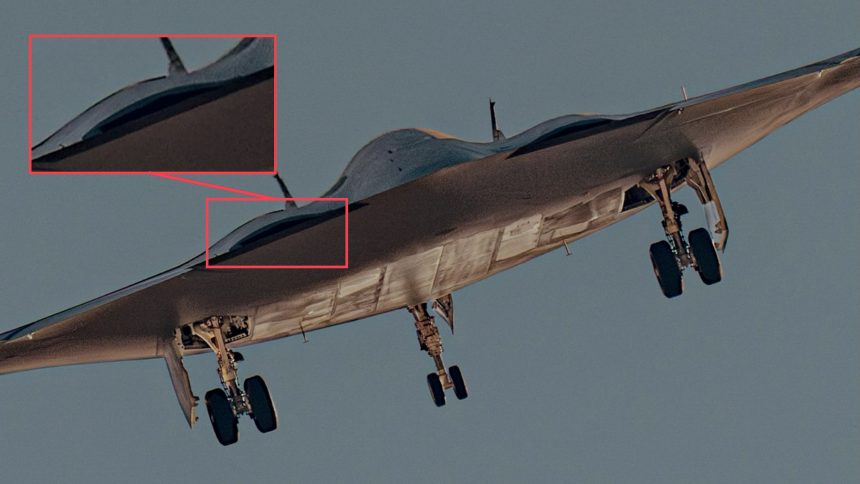A new photo of the second B-21’s first flight offers a new look at the engine exhaust, which appears very similar to the B-2’s one.
Last week, the second B-21 Raider stealth bomber took to the skies for the first time, flying from Palmdale’s Air Force Plant 42 to Edwards Air Force Base, California. A new photo, captured shortly after takeoff, offers a new look at the engine exhaust of the new bomber.
B-21’s Rear End
Official photos released since the rollout of the B-21 always avoided showing the rear end of the bomber. However, a photo of it already emerged in October 2023, captured during ground testing outside of the bomber’s Palmdale hangar, as we reported on that occasion here at The Aviationist.
On that first occasion, the photo was captured from a distance and quite blurry because of haze and heat distortion. This time, the image is quite clear, and the shape of the nozzle is clearly visible.
B-21 Raider early morning departure pic.twitter.com/WjqFhKCfNj
— jmh.creates (@JarodMHamilton) September 19, 2025
Contrary to many observers’ impressions after the first photo, it now appears that the B-21 adopted an exhaust system very similar to the one already seen on the B-2 Spirit. These are designed to reduce as much as possible the infrared signature of the engines, contributing to the low observability of the aircraft.
It is highly likely that, just like the B-2, air from the secondary air intakes is also mixed with the hot exhaust gases to further decrease the temperature. The most notable difference is the absence of the saw-tooth trailing edge found immediately behind the B-2’s exhaust, which on the B-21 has been replaced by a straight edge.
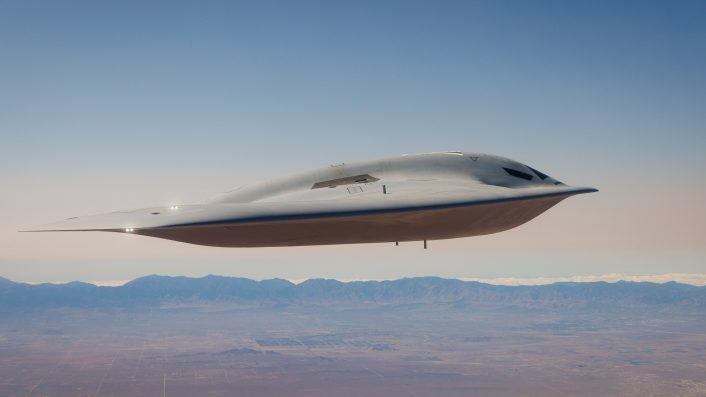
The B-2 Spirit’s Flat Exhaust System
One of the B-2 Spirit’s most distinctive low-observable features is its unusual (at the time) exhaust arrangement. Unlike conventional combat aircraft, the B-2’s four General Electric F118-GE-100 non-afterburning turbofans (a variant of the well-known F110) are completely buried within the airframe, with no exposed round nozzles visible.
Instead, the hot exhaust gases are routed through long internal ducts before being expelled through broad, shallow slot-like outlets on the upper surface at the trailing edge of the wing. This configuration serves several purposes.
First, it shields the hottest parts of the engines -combustors and turbines – and the exhaust plume from direct line of sight, especially from below, where most infrared (IR) sensors and surface-to-air threats would attempt to detect the bomber. Second, the flat exhaust spreads the flow over a wider area, increasing the mixing with cooler ambient air and bypass air, accelerating plume dissipation.
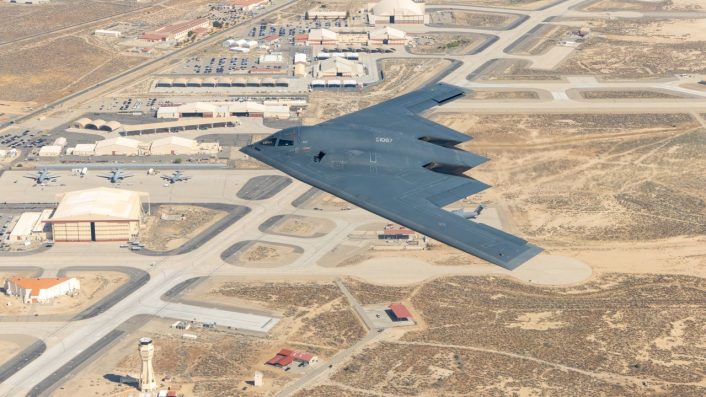
Finally, the B-2’s aft deck structure partially masks the exhaust flow, reducing the infrared output with the help of specialized heat-resistant materials – like titanium and ceramic tiles – to help diffuse residual thermal emissions. The absence of afterburners further limits exhaust temperature.
Such a design introduces engineering challenges, leading to tradeoffs which are however essential to the B-2’s mission. The bomber was designed to penetrate dense air defense systems, thus minimizing its detectability across radar and infrared spectrums was prioritized over raw engine performance.
Exhaust Designs in Stealth Aircraft
The B-2 is not the only stealth aircraft to employ unconventional exhaust solutions. Earlier, the F-117 Nighthawk was another notable case, as it used a pair of flat, wide exhausts positioned above the rear fuselage.
Much like the B-2, these nozzles mixed hot exhaust with ambient air and directed the plume across the aircraft’s upper surface to shield it from sensors below, using a mix of small channels, bypass air and “heat-reflecting” materials. However, the Nighthawk’s smaller size and less advanced materials technology at that time limited its efficiency, with the aircraft still generating a noticeable infrared signature compared to more modern designs.
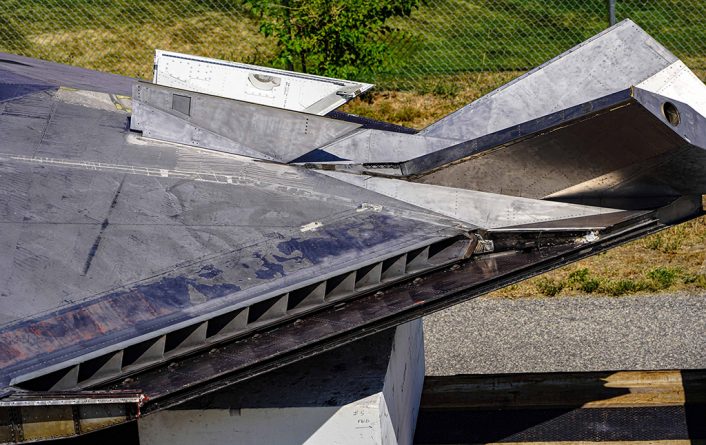
Later stealth aircraft adopted different approaches. The F-22 Raptor, for instance, employs rectangular thrust-vectoring nozzles. These maintain a degree of infrared suppression by spreading the plume while also providing exceptional maneuverability. However, they remain more exposed than the deeply buried exhausts of the B-2 or F-117, reflecting the Raptor’s design balance between low observability and high-performance air combat capability.
The F-35 Lightning II returns to a more conventional, round nozzle layout, albeit heavily optimized with serrated edges, signature-reducing materials, and thermal management measures. Its stealth relies more heavily on radar-cross-section reduction, with infrared signature management considered less critical given its different mission set compared to the B-2 or F-117.
Stealthy unmanned combat air vehicle (UCAV) demonstrators such as the Northrop Grumman X-47B also adopt flattened, shielded exhaust systems that echo lessons from the B-2 and F-117. The X-47B routes its engine exhaust through a long, shallow rectangular nozzle recessed into the upper rear fuselage.
As can be noticed, stealth aircraft exhaust designs vary depending on operational requirements, requiring different tradeoffs to achieve the goal. Dedicated strike platforms like the B-2 prioritize infrared masking over efficiency, while multirole fighters such as the F-22 and F-35 adopt compromises between stealth, agility, and thrust performance.
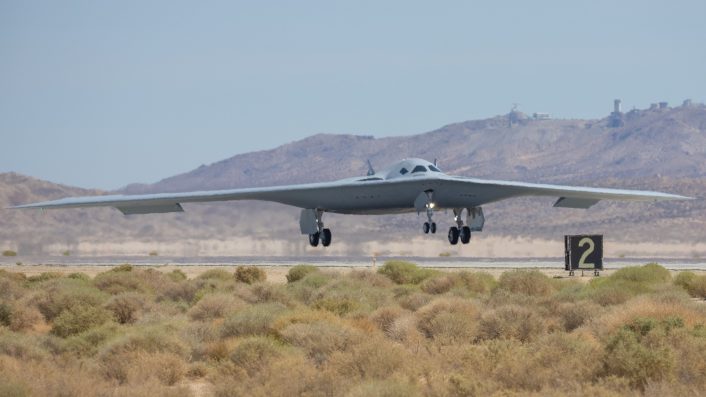
The Second B-21 Raider
On Sept. 11, 2025, the U.S. Air Force’s second flight-worthy B-21 Raider, known as T-2, successfully completed its maiden flight. The stealth bomber departed from Air Force Plant 42 in Palmdale, California, accompanied by an F-16 chase aircraft, before landing at Edwards Air Force Base.
There the Raider joined the first B-21, T-1, which has been flying since November 2023. As we reported here at The Aviationist, the second Raider marks a significant step forward in the program, bringing additional capacity to the ongoing test campaign.
Alongside the two flying prototypes, two additional aircraft, G-1 and G-2, are dedicated to ground testing. This mix allows the test campaign to run in parallel, accelerating the pace of evaluation and reducing risk as the program moves closer to production.
With T-2 now flying, the Air Force can divide tasks between the two airborne Raiders and progress into the next phase of testing. The service will in fact use this second B-21, which is production-representative, to expand testing into weapons integration and sustainment assessments.
Thank you to Jarod Hamilton for allowing us to use his photo. Be sure to check out and follow him on X and Instagram.

